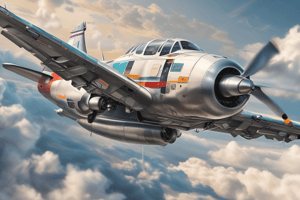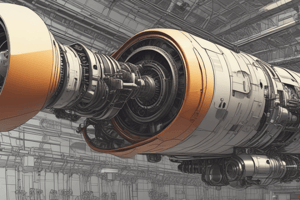Podcast
Questions and Answers
According to the knowledge levels defined in the document, what characterizes Level 1?
According to the knowledge levels defined in the document, what characterizes Level 1?
- Detailed knowledge, capacity to combine, practical application
- Familiarity with basic elements, simple description, typical terms (correct)
- General knowledge, ability to apply, use mathematical formulae
What is expected of an applicant at Level 2 of the knowledge levels?
What is expected of an applicant at Level 2 of the knowledge levels?
- A general understanding, ability to apply knowledge practically (correct)
- Giving detailed descriptions and using specific examples
- Understanding theoretical fundamentals only
What does Level 3 require from the applicant?
What does Level 3 require from the applicant?
- Familiarity with basic elements, simple description
- Understanding theoretical fundamentals, using mathematical formulae
- Knowing theory, interrelationships, detailed descriptions (correct)
What is the purpose of emergency equipment on passenger aircraft?
What is the purpose of emergency equipment on passenger aircraft?
Which of the following are examples of typical emergency equipment on passenger aircraft? Select all that apply.
Which of the following are examples of typical emergency equipment on passenger aircraft? Select all that apply.
Escape slides are used for evacuating passengers from the aircraft in case of emergency.
Escape slides are used for evacuating passengers from the aircraft in case of emergency.
_______ is a typical emergency equipment used for cabin decompression.
_______ is a typical emergency equipment used for cabin decompression.
What are the types of cabin layouts in commercial air travel?
What are the types of cabin layouts in commercial air travel?
Reduced seat pitch can be compensated by thicker seat-back design.
Reduced seat pitch can be compensated by thicker seat-back design.
What is the purpose of the Air Return Grilles in a passenger cabin?
What is the purpose of the Air Return Grilles in a passenger cabin?
What types of fire extinguishers are commonly found on aircraft?
What types of fire extinguishers are commonly found on aircraft?
Halon extinguishers are currently the most widely used type of extinguisher on aircraft.
Halon extinguishers are currently the most widely used type of extinguisher on aircraft.
What is the purpose of a fire axe on an aircraft?
What is the purpose of a fire axe on an aircraft?
Protective breathing equipment (PBE) supplies a smokeless head envelope and a source of air for firefighting operations in galley areas and ____________.
Protective breathing equipment (PBE) supplies a smokeless head envelope and a source of air for firefighting operations in galley areas and ____________.
Match the emergency equipment with its location:
- Life vests
- Oxygen bottles
- First aid kits
Match the emergency equipment with its location:
- Life vests
- Oxygen bottles
- First aid kits
What are some examples of loose emergency equipment mentioned in the text?
What are some examples of loose emergency equipment mentioned in the text?
What provides high-pressure air to inflate the escape slide?
What provides high-pressure air to inflate the escape slide?
Emergency slides are typically stowed on a cabin door.
Emergency slides are typically stowed on a cabin door.
Slides are inflated automatically when a door is opened in the ______ position.
Slides are inflated automatically when a door is opened in the ______ position.
Match the emergency equipment with its description:
Match the emergency equipment with its description:
What is the purpose of galleys in aircraft?
What is the purpose of galleys in aircraft?
Dry galleys are connected to aircraft systems like ventilation and potable water.
Dry galleys are connected to aircraft systems like ventilation and potable water.
Explain the attachment points for upper ceiling attachment of galleys.
Explain the attachment points for upper ceiling attachment of galleys.
Lavatories on aircraft are equipped with hot and cold water taps, fresh air gasper outlet, oxygen generator and mask, smoke detector, and automatic fire extinguisher in the ________.
Lavatories on aircraft are equipped with hot and cold water taps, fresh air gasper outlet, oxygen generator and mask, smoke detector, and automatic fire extinguisher in the ________.
Match the following types of compartments with their descriptions:
Match the following types of compartments with their descriptions:
Flashcards are hidden until you start studying
Study Notes
Category B1 Licence and Knowledge Levels
- Category B1 Licence is part of CASA B1-11c, which covers Aeroplane Systems - Airframe.
- The knowledge levels for Category A, B1, and B2 Aircraft Maintenance Licences are indicated by the allocation of knowledge levels indicators (1, 2, or 3) against each applicable subject.
Knowledge Levels
- Level 1:
- Familiarity with basic elements of the subject.
- Ability to give a simple description of the whole subject using common words and examples.
- Ability to use typical terms.
Level 2
- General knowledge of theoretical and practical aspects of the subject.
- Ability to apply that knowledge.
- Objectives:
- Understand theoretical fundamentals of the subject.
- Give a general description of the subject using typical examples.
- Use mathematical formulae in conjunction with physical laws describing the subject.
- Read and understand sketches, drawings, and schematics describing the subject.
- Apply knowledge in a practical manner using detailed procedures.
Level 3
- Detailed knowledge of theoretical and practical aspects of the subject.
- Capacity to combine and apply separate elements of knowledge in a logical and comprehensive manner.
- Objectives:
- Know the theory of the subject and interrelationships with other subjects.
- Give a detailed description of the subject using theoretical fundamentals and specific examples.
- Understand and use mathematical formulae related to the subject.
- Read, understand, and prepare sketches, simple drawings, and schematics describing the subject.
- Apply knowledge in a practical manner using manufacturer's instructions.
- Interpret results from various sources and measurements and apply corrective action where appropriate.### Equipment and Cabin Furnishings
Emergency Equipment and Installations
- Types of emergency equipment: • Escape slides • Life rafts • Fire extinguishers • Protective breathing equipment • Cabin portable oxygen bottles • ELT, ELB, and EPIRBs • Megaphone • Torches (flashlights) • First aid kits
- Emergency equipment locations
- Off-wing escape slide deployment
Seats, Harnesses, and Belts
- Flight deck layout
- Flight crew seats
- Flight crew seat tracks
- Observer seats
- Attendant seats
- Passenger seats
- Safety harnesses
Cabin Layout and Furnishing Installation
- Types of cabin layouts
- Cabin furnishing installation
- Cabin furnishings (e.g., linings, air return grilles, overhead stowage bins)
- Attendant stations
- Floor coverings
Cabin Entertainment Systems
- In-flight entertainment systems
Galley Installation
- Galleys
- Attachment points
- Lavatories
Cargo Handling and Retention Equipment
- Cargo compartments
- Cargo handling equipment
Airstairs
- Retractable airstairs
Fuel Systems
Aircraft Fuel Systems
- Fuel system operation
- System layout
- Gravity-feed systems
- Pressure feed fuel systems
Fuel Tanks
- Fuel tank construction and features
- Bladder tanks
- Integral fuel tanks
- Rigid tanks
- Auxiliary tanks
Fuel Supply System
- Typical multi-engine aircraft fuel supply systems
- Boost pumps
- Pressure switches
- Jet pumps
- Suction valves (bypass valves)
- Check valve
- Engine shut-off valve (low-pressure valve)
Hydraulic Power
Hydraulic System
- System applications
- Hydraulic system capability
- Theory of operation
- Basic hydraulic system
- Open centre circuits
- Closed centre circuits
- Power packs
- Electro-hydrostatic actuator
Hydraulic Fluids
- Major characteristics of hydraulic fluids
- Types of aircraft hydraulic fluid
- Hydraulic fluid contamination
Hydraulic Reservoirs and Accumulators
- Reservoirs
- Standpipe
- Reservoir pressurisation system
- Reservoir servicing
- Hydraulic accumulators
- Accumulator types
- Gas pressure
- Air valves
- Accumulator servicing panel
Landing Gear
Landing Gear Operation and Construction
- Landing gear operations
- Tricycle landing gear
- Wheelbase and wheel track
- Camber
- Conventional landing gear (tail dragger)
- Main landing gear
- Nose landing gear
- Tail wheels
- Tail skids
Non-Shock-Absorbing Landing Gear
- Operation of non-shock-absorbing landing gear
- Rigid landing gear
- Bungee or shock cord landing gear
- Spring steel landing gear
Shock-Absorbing Landing Gear
- Shock absorption
- Spring-Oleo landing gear
- Oleo pneumatic (air-oil) shock strut
- Metering pin type
- Strut operation during landing
- Strut operation during take-off
- Oleo strut inspection
- Oleo strut servicing
Brakes
Aeroplane Brakes
- Self-energising brakes (drum brake system)
- Non-self-energising brakes (disc brake system)
- Single-disc brake
- Multiple-disc steel brakes
- Carbon brakes
- Automatic brake adjusters
- Brake assembly wear pin indicator
- Brake inspection, defects and damage
Hydraulic Braking Systems
- Types of hydraulic braking systems
- Low-pressure braking systems
- Low-pressure system – brake master cylinder
- Low-pressure system – compensator port
- High-pressure braking systems
- High-pressure brake system – brake pedals
- High-pressure brake system – metering valves
- High-pressure brake system – flow limiters and fuses
- High-pressure brake system – accumulator<|start_header_id|><|start_header_id|>
Studying That Suits You
Use AI to generate personalized quizzes and flashcards to suit your learning preferences.




